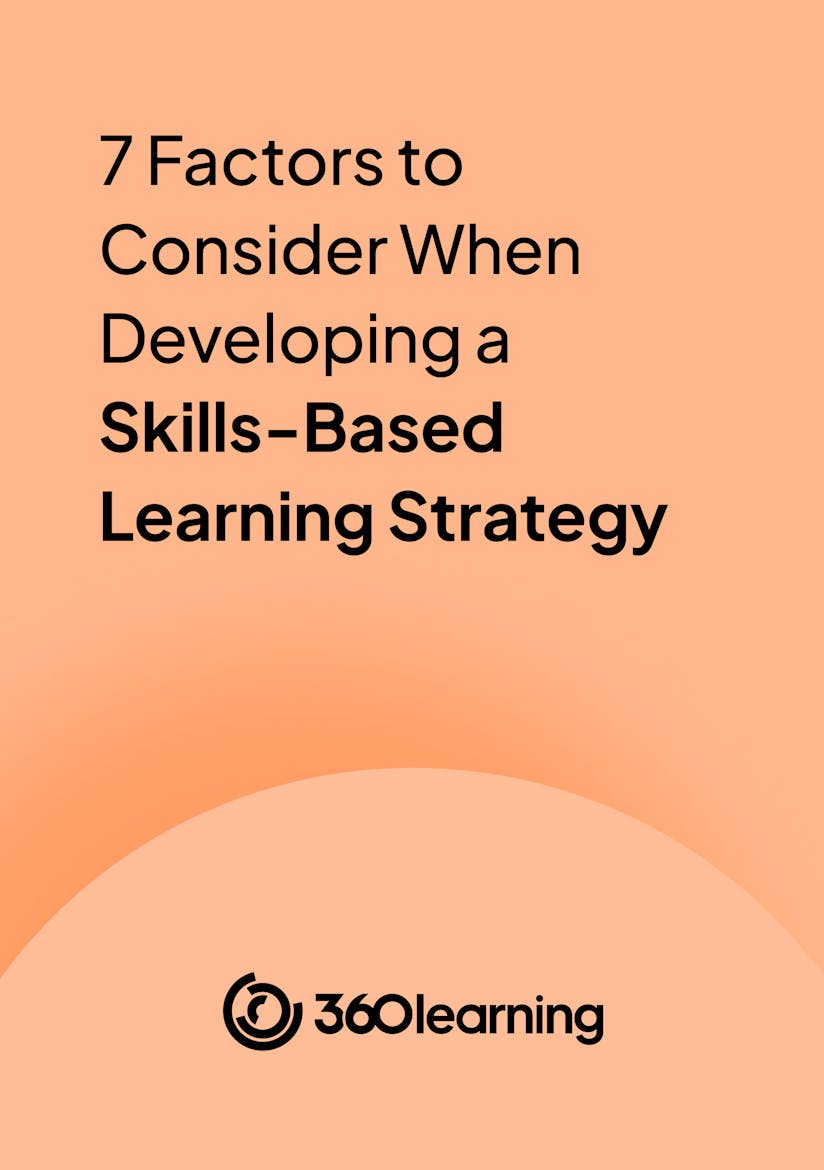
Goodbye Jobs, Hello Skills: The Fundamental Shift Reshaping the Way We Think About Talent
In competitive markets, attracting and retaining the best talent is the only way for companies to thrive. We need the right people at the right time–and we need to pivot when the market changes.
Unfortunately, a lot of leaders are thinking about this question the wrong way. Instead of focusing on the skills they need to attract and develop internally, they’re stuck thinking in terms of fixed sets of duties and responsibilities and how to hire for them. In short, they’re thinking about jobs, not skills.
In this article, I’ll explore the fundamental shift reshaping the way leading companies are thinking about talent, and the six pillars of making the shift from a job-based operating model to a skills-based one. I’ll show how this focus can make organizations everywhere more flexible, resilient, and competitive.
Let’s start by taking a look at a question keeping a lot of CEOs up at night.

Guarantee a successful move to skills-based L&D
By providing your contact info, you agree to receive communications from 360Learning. You can opt-out at any time. For details, refer to our Privacy Policy.
For 75% of CEOs, skills are the biggest bottleneck to growth
We recently had a chat with Neobrain CEO Paul Courtaud about the challenges and opportunities involved with making a switch to a skills-based operating model. According to him, whenever he asks CEOs what’s getting in the way of growing their company to the next level, he gets the same response: either it takes far too long to find the right talent, or the talent simply doesn’t exist in the market. This is a major problem, and a tricky one to solve.
For example, let’s think about the major evolutions taking place in green hydrogen. With so many countries and regions moving towards sustainable energy, energy companies need a steady and dependable source of skilled hydrogen engineers. Unfortunately, there simply aren’t enough of these engineers in the market.
You can throw around all the money and perks you like, but it won’t solve this fundamental issue. When valuable skills and experience are scarce, organizations need an entirely new way to think about resource allocation–and an entirely new way to empower skilled people.
That’s why leading companies are starting to think differently about talent.
How leading companies are thinking about talent differently
Traditional notions of how companies hire and retain talent aren’t enough for the present moment. Rather than setting annual skills roadmaps and hiring accordingly, organizations need to reallocate and optimize available skills and resources quickly and dynamically in response to market signals.
Deloitte explores this trend towards skills-based organizations in its 2022 article, noting how leading companies are applying skills-based models to meet demands for greater agility, agency, and equity in the workplace.
As this article notes: “Confining work to standardized tasks done in a functional job, and then making all decisions about workers based on their job in the organizational hierarchy, hinders some of today’s most critical organizational objectives: agility, growth, and innovation; diversity, inclusion, and equity; and the ability to offer a positive workforce experience for people.”
Emphasizing skills, not jobs, as the essential building block of talent
To address this limitation, leading companies are now moving towards a new operating model that emphasizes skills, not jobs, as the essential building block of workforce talent. As Anish Singh, Head of HR for Unilever in Australia and New Zealand, notes: “We’re beginning to think about each role at Unilever as a collection of skills, rather than simply a job title.”
Leaders are showing a lot of interest in a skills-based operating model: 81% of executives surveyed by Deloitte preferred either a fractionalized work model where workers flow towards projects based on their skills and interests (60% of respondents), or a broadened work model where worker roles are structured around desired outcomes (21% of respondents). Just 19% preferred a traditional jobs-based operating model.
This model also empowers people to apply their skills more fluidly to projects and tasks across the organization, rather than being limited to just a single set of responsibilities. And with 55% of workers saying they either already have, or are likely to, switch employment models throughout their careers (e.g. shifting from project to project via an internal talent marketplace), this kind of flexibility is a huge added bonus for your most talented people, too.
So, how can we make this shift?
Our 6-step blueprint to make the move from jobs to skills
Shifting from a traditional jobs-based operating model to a skills-based model might sound daunting, but it can be boiled down to six key steps.
1. Conduct a skills self-assessment
First up, start by running a self-assessment of the existing skills within your organization. This involves two steps:
- Setting up an AI-powered skills ontology. You can use AI tools to quickly generate a dynamically enriched list of skills for each job in your organization. Once curated with these AI tools, you can then validate this with your HR advisors, managers, and leadership.
- Assess employees on these skills. With this skills ontology, you can then assess your teams through self-assessment, manager assessment, peer-based assessment, or through external third-party tests. This will give you a sense of the level of proficiency in each skill, and the level of interest on behalf of each team member in developing these skills further.
With this detailed sense of the status quo, you can build a sense of where your talented people want to go next.
2. Provide each employee with visibility on their potential next step
Based on the skills profiles developed in step one, you can then build an opportunity marketplace to help promote internal opportunities for different roles based on company priorities.
By providing this level of visibility, you can give your employees the chance to project themselves into new opportunities within the organization, rather than heading to LinkedIn to search for their potential new roles.
3. Adjust your learning strategy to match these goals
Once you have a sense of your workforce’s advancement goals and the skills needed to support the achievement of these goals, you can build a focus on the right learning experiences. Here’s how to make this happen:
- First, tag your content to show the skills you want to develop.
- Second, identify the skills gap at the employee level. This might involve a gap in their current role (i.e. on which skills should they improve to perform better today?), or their desired next role (i.e. what skills are they missing for their next role?). Then, you can make sure you have the right content to help them close these gaps.
- Next, if content is lacking, you can identify subject-matter experts based on their skills profiles to help you create the right learning experiences to close these gaps.
- With your content up and running, use AI-powered learning recommendations to ensure employees are getting the right recommendations to close skills gaps.
- Finally, measure the impact of these learning experiences in closing skills gaps and increasing flexibility and adaptability.
Next up: performance management.
4. Make the move to skills-based performance management
Next up, you need to reflect this focus on skills within your performance management processes. Managers and coaches should be talking about skills continuously with their teams, and should be making skills development a core focus during performance reviews.
Incorporating this focus in your performance management can give your managers and coaches valuable new ways to identify the aspirations within their teams, and to make room for people to achieve these aspirations by developing new skills or applying existing ones.
5. Pivot to skills-based hiring over experience-based hiring
Alongside skills-based performance management, a more fundamental shift is the move to skills-based hiring, rather than experience-based hiring. This involves defining open roles primarily in terms of the skills your organization needs, rather than the experience candidates will be expected to demonstrate.
A skills-based hiring process focuses on evaluating candidates based on the capabilities they could bring to your organization, rather than on their education or past work experience.
6. Integrate a focus on skills into your strategic workforce planning
To wrap up each of these six steps, you need to reflect this focus on skills in your strategic workforce planning. For larger-scale manufacturing organizations, this might also include key changes to core production processes.
With the detailed skills information you’ve gathered through steps one through five, your HR team can now more closely align your business and people strategies. This means getting a clearer sense of the skills profile of your current workforce, and the specific steps you need to complete to get to your target stage.
For example, how can your organization reach a point where you are redeploying existing employees through upskilling and reskilling, rather than just hiring externally? And how can you manage this redeployment for specific initiatives?
Let’s look at a real-world example of this strategic workforce planning. Global technology and engineering company Bosch faced the prospect of making up to 1,400 layoffs due to a transition in the market away from diesel technology, however, with a shift to a skills-based operating model, the company was able to retain 800 of these roles through entering a subcontracting relationship with Airbus to apply engineering skills in different projects.
One last thing to remember: making the transition from a jobs-based operating model to a skills-based operating model can take time. The traditional focus on specific roles is so firmly embedded in the way we attract, engage, and retain talent that it can take months if not years to make this switch. There are also certain jobs and industries where moving too fast with this pivot can create the risk of churn.
Related article: The Answers are Right Here: Upskill From Within and Get Up to Speed with Your Next Big Idea
Flexibility, resilience, agility: why the shift to skills matters
The COVID-19 pandemic pushed companies to be faster and more nimble in responding to market signals on skills. Now, organizations everywhere have the opportunity to build on this shift and make a lasting move towards an operating model based on skills, not jobs.
As Deloitte notes, a skills-based operating model has the potential to deliver greater agility, agency, and equity in the workplace. By thinking less about hiring to match people against fixed sets of duties and more about a set of skills that could be applied fluidly to advance priority projects, we can deliver greater organizational performance and engage key talent.
This transformation won’t happen overnight; after all, we’re unpacking decades, if not centuries, of conventional wisdom. But if we can get this right, we can change the way our organizations respond to opportunities and threats in the market; engage our most talented people to develop and share new skills; and re-define what work means for good.

